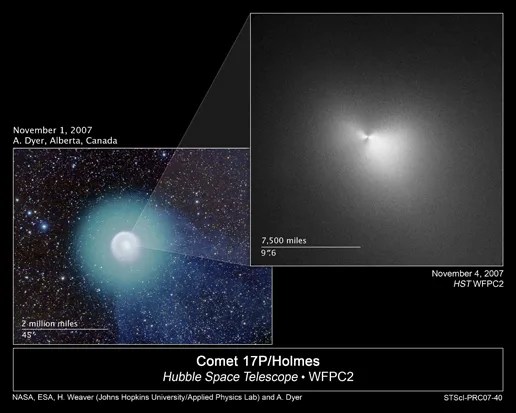4 min read
NASA's Hubble Space Telescope has probed the bright core of Comet17P/Holmes, which, to the delight of sky watchers, mysteriouslybrightened by nearly a millionfold in a 24-hour period beginning Oct.23, 2007.
Image above:
Images of Comet 17P/Holmes as seen from the ground (left) and the Hubble Space Telescope (right).
Click image for enlargement.
Credit:
A. Dyer, Alberta, Canada (left); NASA/ESA/H. Weaver/The Johns Hopkins University Applied Physics Laboratory (right)
Astronomers used Hubble's powerful resolution to study Comet Holmes'core for clues about how the comet brightened. The orbitingobservatory's Wide Field Planetary Camera 2 (WFPC2) monitored the cometfor several days, snapping images on Oct. 29, Oct. 31, and Nov. 4.Hubble's crisp "eye" can see objects as small as 33 miles (54kilometers) across, providing the sharpest most detailed view yet of thesource of the spectacular brightening.
The Hubble image at right, taken Nov. 4, shows the heart of the comet.The central portion of the image has been specially processed tohighlight variations in the dust distribution near the nucleus. Abouttwice as much dust along lies along the east-west direction (thehorizontal direction) as along the north-south direction (the verticaldirection), giving the comet a "bow tie" appearance.
The composite color image at left, taken Nov. 1 by an amateurastronomer, shows the complex structure of the entire coma, consistingof concentric shells of dust and a faint tail emanating from the comet'sright side.
The nucleus-the small solid body that is the ultimate source of all thecomet's activity-is still swaddled in bright dust, even 12 days afterthe spectacular outburst. "Most of what Hubble sees is sunlightscattered from microscopic particles," explained Hal Weaver of The JohnsHopkins University Applied Physics Laboratory in Laurel, Md., who ledthe Hubble investigation. "But we may finally be starting to detect theemergence of the nucleus itself in this final Hubble image."
Hubble first observed Comet 17P/Holmes on June 15, 1999, when there wasvirtually no dusty shroud around the nucleus. From that observation,astronomers deduced that the nucleus had a diameter of approximately 2.1miles (3.4 kilometers), about the length of New York City's CentralPark. Astronomers hope to use the new Hubble images to determine thesize of the comet's nucleus to see how much of it was blasted awayduring the outburst.
Hubble's two earlier snapshots of Comet Holmes also showed someinteresting features. On Oct. 29, the telescope spied three "spurs" ofdust emanating from the nucleus, while the Hubble images taken on Oct.31 revealed an outburst of dust just west of the nucleus.
The Hubble images, however, do not show any large fragments near thenucleus of Comet Holmes, unlike the case of Comet73P/Schwassmann-Wachmann 3 (SW3). In the spring of 2006 Hubbleobservations revealed a multitude of "mini-comets" ejected by SW3 afterthe comet increased dramatically in brightness.
Ground-based images of Comet Holmes show a large, sphericallysymmetrical cloud of dust that is offset from the nucleus, suggestingthat a large fragment did break off and subsequently disintegrated intotiny dust particles after moving away from the main nucleus.
Unfortunately, the huge amount of dust near the comet's nucleus and thecomet's relatively large distance from Earth (149 million miles, or 1.6astronomical units, for Holmes versus 9 million, or 0.1 astronomicalunit for SW3), make detecting fragments near Holmes nearly impossibleright now, unless the fragments are nearly as large as the nucleusitself.
The Hubble Comet Holmes observing team comprises H. Weaver and C. Lisse(The Johns Hopkins University Applied Physics Laboratory); P. Lamy(Laboratoire d'Astrophysique de Marseille, France); I. Toth (KonkolyObservatory, Hungary); M. Mutchler (Space Telescope Science Institute);W. Reach (California Institute of Technology); and J. Vaubaillon(California Institute of Technology).
The Hubble Space Telescope is a project of international cooperationbetween NASA and the European Space Agency. The Space Telescope ScienceInstitute conducts Hubble science operations. The institute is operatedfor NASA by the Association of Universities for Research in Astronomy,Inc., Washington.
The Applied Physics Laboratory (APL) is a not-for-profit laboratory anddivision of The Johns Hopkins University. APL conducts research anddevelopment primarily for national security and for nondefense projectsof national and global significance. APL is located midway betweenBaltimore and Washington, D.C., in Laurel, Md.
Related links:
Donna Weaver/Ray Villard
Space Telescope Science Institute, Baltimore, Md.








